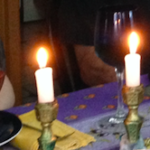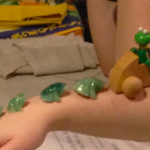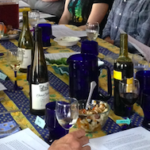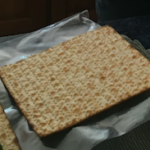Digital Inclusion Haggadah (Seder Book)
Copyright 2020 Katherine Lato & Barry Glicklich
Feel free to use and adapt as best suits your needs. This material was developed for an in-person seder as part of the National Digital Inclusion Alliance conference in 2020. That conference was postponed. This material can be adapted to on-line use if you wish.
Introduction
Welcome to our Digital Inclusion Passover Seder. The focus of this evening is on discussing digital inclusion within the framework of a seder and incorporating elements of a traditional Passover seder. We will provide a little context about traditional practice as it comes up. Seder is the Hebrew word for order, and there has been a long tradition that has built up to define that order. For several decades, liberal jews have been reinterpreting the traditions of our forebearers, bringing contemporary thought and practice to the seder. For example, putting on a skit to tell the story of liberation from slavery, or writing a poem to invoke a modern version of the four questions. Tonight, we are continuing that tradition of reinterpretation, and we invite you to join in. Ask questions, raise a topic, or provide a new perspective of interpreting old traditions.
Traditionally, the seder begins with a call that “All who are hungry, come and eat!” We echo that, and encourage that all who seek connection to the digital world, come and participate within the guidance of your local health authorities, with an on-line option as appropriate.
Candle Lighting
 Traditionally, candles are lit at the beginning of a festival as the sun goes down. Together, we will light these candles in the hope that policy makers increase their awareness of the challenges facing those in all of our communities and work to eliminate barriers to participation.
Traditionally, candles are lit at the beginning of a festival as the sun goes down. Together, we will light these candles in the hope that policy makers increase their awareness of the challenges facing those in all of our communities and work to eliminate barriers to participation.
May the light of these candles provide the illumination needed to provide solutions that include digital access for everyone.
First Cup of Wine
Traditionally, four cups of wine or juice are consumed at the seder. The number four shows up a lot at the seder, and these are often used to highlight different quadrants or aspects of an issue.
For the first glass, we will focus on awareness.
We raise our glasses to the efforts of all within our community who work to increase the visibility of the digital divide and draw attention to those who need assistance becoming digital citizens.
Hand Washing without blessing (skip)
In a traditional seder, we wash our hands at this point without a blessing. We shall skip this part.
Dipping a Vegetable in Salt Water
The Jewish calendar is tied to the seasons of the year, and Passover is a spring festival. The green vegetable, usually parsley, represents spring and the reawakening of the earth. Salt water is representative of the tears of those oppressed by slavery. We dip the green vegetable into the salt water and say:
May the dawning of a new year, symbolized by spring, help us to overcome the tears and frustration of those being held captive by systems and institutions that restrict their access to the digital resources of the world.
Breaking the Middle Matzah
Matzah is an unleavened bread (no rising agents), in which the process is carefully watched and timed. The story goes that when the Hebrews were finally allowed to leave Egypt, they were in such a hurry that there was no time to allow the dough to rise, and that is why this unleavened bread is associated with Passover.
During the seder, 3 pieces of matzah are stacked on a plate with cloth between them.
The explanations of why there are three of them and why we break the middle one are diverse and arcane. Perhaps it was invented by parents trying to keep the interest of the children, so they developed the tradition of breaking the middle matzah, hiding it some time during the seder, and requiring it to be found (and usually redeemed for a ransom) before the seder can be completed.
Many interpretations discuss the middle matzah as the epitome of a bread of poverty, not only flat and without flavoring, but broken too. It is kept on the table as a symbol of poverty throughout the meal.
Discussion: What symbol would you use to represent digital exclusion?
The Seder Plate
These are traditional items on the seder plate:
- Bitter herbs (two types) – used as a symbol of the bitterness of slavery
- Charoset – chopped fruit & nuts, represents the mortar used by the slaves to stack bricks in Egypt
- Green vegetable, such as parsley – represents hope and renewal.
- Shankbone (or beet or sweet potato) – symbol of the Passover sacrifice which was a lamb offered in the temple, then roasted and eaten. Since the temple was destroyed, it is not eaten or handled during the seder. Vegetarians can substitute a beet.
- Roasted hard-boiled egg – symbol of the festival sacrifice and of mourning, so the idea is mourning the destruction of the temple. It is not eaten or handled during the seder, although the first course at a seder is often eggs.
- Orange – to symbolize those who are often not included.
The orange has been added in recent decades as a symbol of inclusiveness, welcoming those who, like the LGBTQ community, have been excluded from many aspects of society. As we focus on digital inclusion, we are reminded to always ask the question “Who is impacted by an issue, but doesn’t have a spot at the table?”
We could reimagine the seder plate so as to have:
hotspot, wifi adapter, Digital Equity Act legislation, redlining maps, library card, cell phone, bridging the gap brochure
Your exercise is, in a small group, to identify an item that is symbolic of some aspect of digital inclusion or digital exclusion. It doesn’t need to be food related, but it should fit on a seder plate. (Can be miniature version—like a matchbox truck instead of an actual truck. And can be a drawing of a matchbox truck rather than an actual matchbox truck.) We will get together in the larger group and share how our item can help us talk about digital inclusion.
Telling the Story
A key part of Passover is telling the story of freedom of the Israelites. Having a narrative is an important part of tradition.
Traditional story:
After the Jews lived in Egypt for many years, the Pharaoh became concerned about there being too many Jews in Egypt. He instituted slavery and demanded that male Jewish children be killed. Moses is saved by his mother and sister. The Pharaoh’s daughter finds him floating down the Nile and adopts him.
Moses grows up as the pampered son of the Pharaoh’s daughter, but one day kills a taskmaster who is beating a slave. Moses flees into the desert. The story is that God appears as a burning bush telling Moses to lead the Jews out of slavery.
Moses asks the Pharaoh to let his people go, and Pharaoh says no a lot (ten plagues). To protect themselves from the final plague (death of the first born), the Jews marked their doors with lamb’s blood so the angel of death would pass over them. (But wait, weren’t the first born already dead if they were male because of Pharaoh’s decree?) The story continues with the Jews being freed from slavery, crossing the Sea of Reeds, and wandering in the desert for 40 years before making it to the promised land.
Discussion: The Sea of Reeds & the digital divide- how can we prevent the waters from closing behind us to allow others to access the freedom we have achieved?
We’re going to ask you to share stories about how your work has impacted an individual or family. Here are a few from our partners:
- Dan Kent of Net Literacy paired a student with a senior for one-on-one computer and internet training. The seniors found that middle and high students teaching them how to use a computer was less threatening and even “cute”, reminding them of their grandchildren. Consequently, they changed the promotional materials to describe the program as one where friendly student volunteers would “adopt” a senior to teach them computer and internet skills on a one-to-one basis. https://www.netliteracy.org
- Grif Peterson from P2PU likes to talk about how the learning circles idea started over 5 years ago when a project at the Chicago Public Library branch in Edgewater talked about how to address low completion rates for online courses. At another branch, there were people in an interview course who said that the questions/curriculum that they were presented with online were not useful and related to their career fields. The group themselves came up with better questions and continued to meet and complete the coursework. It is inspiring how a group can help each other learn without anyone being in charge or trained for that. “Each person is an expert in their life experiences. They create their own learning space.” https://www.p2pu.org/en/
- A Tech Goes Home trainer relates that a recent Small Business Graduate was in a shelter when she started the TGH program. Although she had always dreamed of opening a business, she never thought it would be possible. As she went through the course she began to see her vision as a reality. During her final presentation for the course, she said, “At first I saw my dream as impossible, but with perseverance, resources, and courses like TGH, the dream of owning my own business can become a reality.” Since the end of the course, she has moved out of a shelter into her own home, and is taking steps to open her own business. https://www.techgoeshome.org/
- Please share a story about how your work has impacted an individual or family.
The Four Questions
Traditionally, the four questions ask “Why is this night different from all other nights?”, and point out things that are unique to the Passover tradition- eating unleavened bread, eating bitter herbs, dipping our foods, and eating while reclining.
Tonight, we are asking why is there a digital divide and how can we address it?
- Why do people have difficulty getting affordable equipment to access the Internet, and how can we help them obtain it?
- Why do people have difficulty getting affordable training to better use technology and the Internet, and how can we help them obtain it?
- Why do people have difficulty getting affordable broadband connectivity and how can we help them obtain it?
- Why do people have difficulty getting the support they need to fully utilize the Internet, and how can we help them obtain it?
Maybe break into groups and address one or two of the questions. Share with larger group.
The Four Children
Traditionally, the story is told of four sons, each representative of aspects of human character: the wise son who studies and wants to learn more details, the wicked son who questions the meaning of the ritual, the simple son who is just trying to get a grasp on what is occurring, and the son who doesn’t know how to ask questions. The seder discusses how each of these needs should be addressed.
For tonight, we will treat the four children as four levels of internet users within our communities, and break into groups to discuss how to reach each of these people where they are:
- Wise- knowledgeable, sometimes doesn’t acknowledge they have more to learn
- Worried- concerned about how to avoid giving away personal information, so avoids using technology
- Weakly connected- lacks the resources to take full advantage of the tools, but has a strong desire to participate
- Wondering- isn’t aware of what benefits could be gained, and hesitates to participate because there is so much they feel they don’t know
Pair off, or count off, into groups of four and within your group, spend ten minutes discussing ideas on how to address the needs of your target audience. Please take notes, and bring your key points back to the larger group.
The Ten Plagues
 Traditionally, as we recount the story of the liberation of the slaves, when we come to the ten plagues, we name them, and for each plague named, we remove a drop of wine from our glass, because even though these plagues resulted in the freedom of the slaves, they each caused difficulties for the residents of Egypt.
Traditionally, as we recount the story of the liberation of the slaves, when we come to the ten plagues, we name them, and for each plague named, we remove a drop of wine from our glass, because even though these plagues resulted in the freedom of the slaves, they each caused difficulties for the residents of Egypt.
Our joy (represented by a full glass of wine) is diminished by the hardships that each of these plagues caused.
Let’s come up with a list of ten plagues of digital exclusion, feel free to add suggestions, and then we can order ten of them.
- On-line only resources, for the difficulty these cause for those without the ability to readily use them.
- Non-accessible websites, for restricting access to information from the differently abled
- Disreputable recyclers, for the damage done to the environment and the recycling/refurbishing industry
- Lack of funding, for the needs of our clients which go unmet because of a resource shortage
- Regulatory restrictions like state rules preventing cities from providing public broadband networks
- Educational broadband spectrum auction, for taking away a public resource for the benefit of telecom carriers
- Non-repairable manufacturing, for shortening the lifespan of products and increasing e-waste
- Broadband redlining, for restricting low-income communities access to affordable broadband
- FCC failures, from Lifeline to Net Neutrality, for favoring corporate interests over those of residents
- Partisan politics, which prevent the representatives from working to address the needs of their citizens
- Public unaware of digital inclusion issues
- Lack of public wifi in low income areas
- License agreements to restrict reuse
- Government control of internet – censorship, shutting down
Dayenu (It would have been enough)
Dayenu – Dayenu is a traditional song sung at passover giving thanks for all the benefits we have received, with a recurring chorus of “It would have been enough for us.”
On the one hand, it would be easy to build a structure on the technologies that we all use in our daily lives, and to be grateful for how one technology builds on another to provide more and more for those of us who have full access to technology. On the other hand, the whole theme for digital inclusion practitioners is that it isn’t enough to have the technology, and more needs to be done to provide access to everyone. We’re taking the opportunity to express appreciation for the positive steps that the digital inclusion community has accomplished, and be grateful that this will allow us to move from strength to strength, helping to create and spread digital equity across the world.
Let’s go around the table, stating things in the digital inclusion space we are grateful for:
These are just a few ideas to get us started:
- Community helping each other
- City initiatives – digital inclusion trailblazers
- CRA credits
- Legislation – Digital Equity Act
- NDIA
- Annual conference
The Second Cup
 There is a tradition that at a Passover seder, particularly when drinking the wine, that participants are to lean or recline. This comes from the story that the noble people would feast while lounging, so this became a symbol for freedom. For us in the digital inclusion world, we’ve heard too many stories of students leaning against library walls after hours with their cell-phones to do homework using library WiFi because they don’t have broadband at home. This makes it harder to have a positive connotation to leaning.
There is a tradition that at a Passover seder, particularly when drinking the wine, that participants are to lean or recline. This comes from the story that the noble people would feast while lounging, so this became a symbol for freedom. For us in the digital inclusion world, we’ve heard too many stories of students leaning against library walls after hours with their cell-phones to do homework using library WiFi because they don’t have broadband at home. This makes it harder to have a positive connotation to leaning.
For the second glass, we will focus on action.
We raise our glasses to the efforts of all those practitioners who strive daily to improve the situation for members of their community, providing equipment, training, broadband connectivity, and support.
Hand Washing with blessing (skip)
At this point in a traditional seder, we wash our hands and say a blessing. We will skip this part.
Eating Matzah
 According to Jewish tradition, leavened breads, cookies or cakes are not to be eaten during Passover. An unleavened bread, matzah, is eaten instead. The Israelites left in such a hurry that they couldn’t wait for the bread to rise. It’s now possible to bake bread quickly, but tradition takes precedence and matzah is still eaten. Matzah that is kosher for Passover has to be made in less than 18 minutes. Matzah is a reminder to be humble and to remember what life was like for those enslaved.
According to Jewish tradition, leavened breads, cookies or cakes are not to be eaten during Passover. An unleavened bread, matzah, is eaten instead. The Israelites left in such a hurry that they couldn’t wait for the bread to rise. It’s now possible to bake bread quickly, but tradition takes precedence and matzah is still eaten. Matzah that is kosher for Passover has to be made in less than 18 minutes. Matzah is a reminder to be humble and to remember what life was like for those enslaved.
Are there things that must be done in a hurry with digital inclusion? Something that people can’t wait around for?
We eat the matzah.
Eating Bitter Herbs
Bitter herbs symbolize the bitterness and harshness of slavery. We must sense the bitterness of slavery to really taste the joy of freedom.
May the taste of these bitter herbs help remind us of the difficulties facing so many of us in gaining access to the digital resources needed to thrive in today’s world.
We eat the bitter herbs.
Eating Matzah and Bitter Herb Sandwich (skip)
At this point in a traditional seder, we eat matzah with bitter herbs, and combine charoset and bitter herbs. We will skip this part.
The Meal
Every festival is celebrated with a meal, and as we hope the food here tonight helps satisfy physical hunger, so may the focus of this seder and the Net Inclusion conference help satisfy the cravings to improve digital access in all of our communities.
Searching for the Afikoman
In the Jewish tradition, children search for the afikoman (the larger half of the middle matzah that was hidden earlier.) The child who finds it is given a prize, and can even bargain for something greater, since the seder can’t continue without the afikoman.
Joy Levitt, “The older we get, the harder the search becomes. We aren’t always sure now what we are seeking, what the afikoman means to us, which dessert will bring us a sense of completion and satisfaction …. But this we know; it is still the search that is important—the looking, the running, and the turning everything upside down.” LOVE THIS QUOTE!
Discussion: What are you searching for that will help advance the cause of digital inclusion in your area of focus?
Eating Dessert and the Afikoman
Blessing After the Meal (skip)
At this point in a traditional seder, we say a blessing after meals. We will skip this part.
The Third Cup of Wine
For the third glass, we will focus on gratitude.
We raise our glasses in thanks for all the accomplishments that have been made by others, for the tools that enable us to pursue our work, and for the incredible energy that those around us bring to address the issue of digital inclusion.
Elijah & Miriam’s Cups
By tradition, Elijah’s cup of wine sits on the table throughout the seder, reminding us that there are those who are not with us now, and who may bring solutions to the issues that we currently face. The door would be opened to allow the spirit of hope for the future to enter and partake in our celebration.
In contemporary tradition, Miriam’s cup has been added, a symbol of the contributions of marginalized groups and of the need for everyone to contribute to the well of knowledge.
Water is critical to life and makes other things possible. We fill this cup to symbolize our role in helping include all in the digital world and enable other capabilities. Everyone pours a little water from their cup into Miriam’s cup.
We open the door for hope of the future to come in.
Psalms (Songs)
Based on: He’s got the whole world in his hands
Main line:
“We need digital inclusion in our land.”
substitute digital inclusion with related phrases:
- Affordable internet
- Broadband fiber
- Refurbished computers
- Free training
- Digital equity
- Smart cities
- More funding
- Rural access
Suggest your own phrases.
The Fourth Cup
For the fourth glass, we will focus on hope.
We raise our glasses in hope that the lessons we have been learning this week will help us move forward more effectively, that our work will impact the lives of those in our communities for the better, and that the coming year provides meaningful progress in our efforts to allow everyone access to tools, knowledge, services, and the support they need to best serve their interests in the digital world.
Conclusion
In a traditional seder, we close with ‘Next Year in Jerusalem, next year in the city of hope.’
For this seder, we close with
‘Next year may all be included, next year may all have hope.’